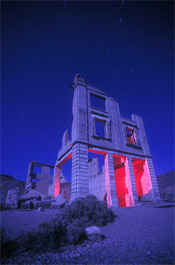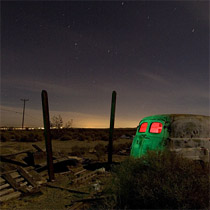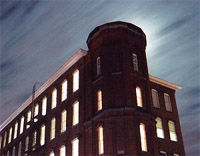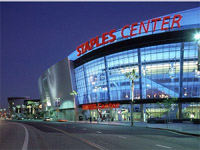
One of the appealing aspects of nighttime photography for me personally is the technical aspect of it, and how it is so different to taking a photograph of a landscape or a portrait. I like how much freedom the photographer has whilst working with long exposures and how they can be manipulated with flashes and moving subjects. I think the ability to capture movement is also an appealing factor. I find it a challenging and diverse aspect of photography and hope to further both my understanding and technical ability with studying it in this unit. I find photographs taken at night to be interesting; as they seem to me to reflect a different side of everyday things we might walk past and not notice particularly, as I found in my initial research. I found through researching Brassai, who comments upon how things look different at night, and his aim was to capture the imagery of Parisian gardens and street life at night during 1930�s.
My aim in this unit is to research and apply some of the techniques of Troy Paiva to my own work. He is an American photographer who shoots mainly at night and in low light, both exteriors and interiors. He specialises in taking photographs of abandoned junkyards, warehouses and ex military buildings. His technique is to use flash units; usually flashguns hand held, but sometimes hand-held torches are used in his photographs for finer details. He often uses theatrical coloured gels on the lights to create strange, ethereal glows to his subjects. I wanted to study this technique as I find so much different to conventional photography. I wish to challenge myself with this unit as working at night brings numerous problems of its own both practically and photographically and I hope to learn from and make good use of the techniques.
There are two main photographers I have chosen to study in depth; the first of these is the photographer Troy Paiva, an American photographer who works mainly at night. He has been photographing the abandoned places of the American West since 1987. His photographs have been published in a book called Lost America. His stark, high contrast, vibrant coloured pictures of abandoned vehicles and structures demand attention and provoke thought. His subjects are often illuminated surreally with brightly coloured lights, often using theatrical lighting gel material covered over flashes or sometimes something as simple as a torch.
In the late 80's, Troy sat a few night photography classes. The subject of light painting came up briefly and something clicked in his mind. Already an explorer of outback ghost towns and abandoned spaces; here were techniques that were perfect to photograph the atmosphere and mystery of modern ghost towns. The long time exposures in his work allow the stars to blur and the clouds to smear ethereally across the sky. Troy Paiva is one of the only photographers I have come across who openly discusses his techniques and some of the messages behind his work. He seems to enjoy discussing his work a lot, which I find is rare, most photographers just leave a location and a date with their work.
By having access to his annotations and essays on his work it is enjoyable to study Troy Paiva; it does not take long for you to realise when reading his notes his passion for urban exploration and night photography. He has an in-depth technique page on his website for budding photographers to learn from and be humoured by his anecdotal and personal advice. He even lists countless photographers on his site that have been influenced by his light painting technique, praising nearly all individually. Paiva stands out for me as a photographer as someone who�s love for photography is so great they want to share their passion with the world so that others can revel in it�s delights. Troy Paiva adapts the fundamental photographical aspect of composure with vibrant coloured lighting to produce haunting, visually stunning interpretations of things once great. His messages and values behind his work are often unobvious, but sometimes by taking away the bright illuminated lighting and looking at the corroded, broken away subjects you can start to imagine their past and what they once were.
Tom Paiva is another photographer I have researched; he works in the San Francisco area in the US and has a passion for night photography and maritime structures. From what I can find about him he is no relation to Troy Paiva, so it must be a large coincidence that they share the same surname and are both nighttime photographers!
Name similarities aside, the two Paiva�s works could not differ more. Though they both specialise in nighttime photography, Tom Paiva specialises in cityscape style photographs using only artificial street lighting to illuminate his vibrant night shots. He is a professional, freelance photographer based in California and has had his own business for over 15 years. He specialises in large format photography of industrial and maritime settings as well as architecture and interiors. Tom has over 70 cover images for various trade magazines to his name. He has published a book, Industrial Night, containing 46 colour images of industrial settings at night. He has co lead photo workshops on night photography over the past 6 years and has had several articles on these subjects in photographic magazines. His nighttime photographs are more conventional than Troy�s, photographing light trails, cityscapes and urban and marine structures. Although conventional, the quality is always fantastic and his shots are vivid and visually outstanding.
Image analysis 1
 It could be said that Troy Paiva takes photographs of two sorts of subjects, vehicles and structures. This shot would obviously come under structures and I think it is one of his best pieces of work visually and the messages behind the shot are even stronger. To take this shot, Troy has used a tripod and an exposure of 8 minutes long on 160T film. Due to the long exposure, trails of stars can be seen in the sky, which is caused by the movement of the earth, blurring the stars in the sky. The shot would also be considerably darker if not left for such a long time period exposed as the building is illuminated only by natural light. As Troy states in his technique section on his website, this long exposure gives him freedom to walk in and out of his shots to do his light painting. For even the faintest image of him to appear in his images he would have to stand still in the same place for at least one minute. Using this information on his technique it is easier to see how he could come out with a shot like this. In this shot he has walked over inside the structure and shot a red gelled strobe flash on the inside of the building several times to give the appearance of civilisation inside the structure. The colour red is prominent due to the blue hues contrasting with it. The shot has been positioned from a low angle to show the building as dominating and quite menacing. Troy�s caption to this photo claims the city this building was in, Rhyolite, was the largest city in Nevada at one point, now it is just a pure ghost town. Irony is strong in this piece; by lighting up the structure it conveys it for being in use, when the reality could not be further from the truth. This is Paiva�s message.
It could be said that Troy Paiva takes photographs of two sorts of subjects, vehicles and structures. This shot would obviously come under structures and I think it is one of his best pieces of work visually and the messages behind the shot are even stronger. To take this shot, Troy has used a tripod and an exposure of 8 minutes long on 160T film. Due to the long exposure, trails of stars can be seen in the sky, which is caused by the movement of the earth, blurring the stars in the sky. The shot would also be considerably darker if not left for such a long time period exposed as the building is illuminated only by natural light. As Troy states in his technique section on his website, this long exposure gives him freedom to walk in and out of his shots to do his light painting. For even the faintest image of him to appear in his images he would have to stand still in the same place for at least one minute. Using this information on his technique it is easier to see how he could come out with a shot like this. In this shot he has walked over inside the structure and shot a red gelled strobe flash on the inside of the building several times to give the appearance of civilisation inside the structure. The colour red is prominent due to the blue hues contrasting with it. The shot has been positioned from a low angle to show the building as dominating and quite menacing. Troy�s caption to this photo claims the city this building was in, Rhyolite, was the largest city in Nevada at one point, now it is just a pure ghost town. Irony is strong in this piece; by lighting up the structure it conveys it for being in use, when the reality could not be further from the truth. This is Paiva�s message.
Image analysis 2
 I like the way this shot is composed, it uses the Rule of Thirds, which makes it pleasing to the eye of the viewer and seems to fill space better. This shot has been taken at night, but cleverly Troy has included some far off civilisation in the image which is the orangey-brown glow on the horizon. This is caused by large amounts of sodium vapour (from street lamp lights, buildings) reflecting on the clouds. The sky almost looks apocalyptic, as if the end of the world is nigh. I think this is the theme that Troy is trying to portray, that once, this sort of van would be a major part of someone�s world, a world that is now all but forgotten and left to literally rot. The inside of the van has been light painted with a red-gelled flash, I think the red illumination always looks good from the inside of buildings and vehicles, pouring out of the van windows makes it really effective and eye catching. The outside of the van has been flashed green with a green-gelled flash to create a good contrast with the windows. The two posts in the shot act as a guide for the viewer�s eyes toward the main subject, which is the van.
I like the way this shot is composed, it uses the Rule of Thirds, which makes it pleasing to the eye of the viewer and seems to fill space better. This shot has been taken at night, but cleverly Troy has included some far off civilisation in the image which is the orangey-brown glow on the horizon. This is caused by large amounts of sodium vapour (from street lamp lights, buildings) reflecting on the clouds. The sky almost looks apocalyptic, as if the end of the world is nigh. I think this is the theme that Troy is trying to portray, that once, this sort of van would be a major part of someone�s world, a world that is now all but forgotten and left to literally rot. The inside of the van has been light painted with a red-gelled flash, I think the red illumination always looks good from the inside of buildings and vehicles, pouring out of the van windows makes it really effective and eye catching. The outside of the van has been flashed green with a green-gelled flash to create a good contrast with the windows. The two posts in the shot act as a guide for the viewer�s eyes toward the main subject, which is the van.
Image analysis 3
 This shot by Tom Paiva is perhaps one of my favourites of all his work. I love the composition and the blur of the clouds. The pinnacle of the building is placed in front of the moon giving it a haunting glow. The blur effect of the clouds is created through the exposure of the shot being long enough to capture the movement of the clouds. Because the building is placed in front of the moon, a slight silhouette is cast on the building, which in turn produces an aesthetically pleasing contrast with the illuminated windows. This shot has been composed similarly to how Troy composed his Bank building, (previously analysed) from a low angle to show the building as dominating and quite menacing. It certainly suggests this building is of some significant importance, whether it is or not I cannot determine. I think that Tom Paiva wished an air of mystery around this shot, and wanted the audience to think about the significance of the building. Due to the main frontage of the building being absent it is impossible to tell what purpose the building holds. This shot complies to the rule of thirds as the building is not placed centrally in the photograph but instead placed to the left slightly, with the pinnacle of the building neither being horizontally central or vertically central. This image is interesting as usually the sky is used as a little bit of space to make the subject appear more prominent, but with this shot the sky is also interesting and eye catching.
This shot by Tom Paiva is perhaps one of my favourites of all his work. I love the composition and the blur of the clouds. The pinnacle of the building is placed in front of the moon giving it a haunting glow. The blur effect of the clouds is created through the exposure of the shot being long enough to capture the movement of the clouds. Because the building is placed in front of the moon, a slight silhouette is cast on the building, which in turn produces an aesthetically pleasing contrast with the illuminated windows. This shot has been composed similarly to how Troy composed his Bank building, (previously analysed) from a low angle to show the building as dominating and quite menacing. It certainly suggests this building is of some significant importance, whether it is or not I cannot determine. I think that Tom Paiva wished an air of mystery around this shot, and wanted the audience to think about the significance of the building. Due to the main frontage of the building being absent it is impossible to tell what purpose the building holds. This shot complies to the rule of thirds as the building is not placed centrally in the photograph but instead placed to the left slightly, with the pinnacle of the building neither being horizontally central or vertically central. This image is interesting as usually the sky is used as a little bit of space to make the subject appear more prominent, but with this shot the sky is also interesting and eye catching.
Image analysis 4
 I like this shot of the Staples superstore. The vibrant colours contrast well with each other and the dark coloured sky. The building is positioned to the right of the shot, complying with the Rule of Thirds, looking more aesthetically pleasing than if the building was positioned right in the centre of the shot. The shot has been exposed for a significant amount of time to produce the vibrant image, as a shorter exposure would not absorb so much light and fail to illuminate the building as you can see it here. Although due to the mass amount of light produced from the store, an extremely long shutter speed is not needed. For example, if a 15 second shutter speed or longer was used the shot would be washed out and overexposed. The shadows in this image are not very prevalent due to the large amount of light emanating from the building. The way in which the building is illuminated looks as if it has been animated or painted. I think Tom Paiva�s message behind this shot is the massive energy-consuming giant, both physically giant and a business giant is a large part of American society. The amount of light and energy being wasted by this large building can be likened to the view that large department stores like this one wipe out smaller local businesses that have been there for years. A comment about mass consumerism is apparent for me in this piece.
I like this shot of the Staples superstore. The vibrant colours contrast well with each other and the dark coloured sky. The building is positioned to the right of the shot, complying with the Rule of Thirds, looking more aesthetically pleasing than if the building was positioned right in the centre of the shot. The shot has been exposed for a significant amount of time to produce the vibrant image, as a shorter exposure would not absorb so much light and fail to illuminate the building as you can see it here. Although due to the mass amount of light produced from the store, an extremely long shutter speed is not needed. For example, if a 15 second shutter speed or longer was used the shot would be washed out and overexposed. The shadows in this image are not very prevalent due to the large amount of light emanating from the building. The way in which the building is illuminated looks as if it has been animated or painted. I think Tom Paiva�s message behind this shot is the massive energy-consuming giant, both physically giant and a business giant is a large part of American society. The amount of light and energy being wasted by this large building can be likened to the view that large department stores like this one wipe out smaller local businesses that have been there for years. A comment about mass consumerism is apparent for me in this piece.
Night photography and light painting is perhaps the most diverse topic I have studied so far, and certainly the most challenging. I have set up some practical assignments for myself to produce some imagery inspired by Troy Paiva�s ideas, techniques and discover some locations. Where they maybe no-go areas for others, for me I will make use of the location, as Troy does. From all of photographers I have researched, I can be influenced by each of them in different ways. With this, I can hopefully produce stunning and interesting imagery based on a combination of their theories and practices. From Brassai I can learn that always searching for the strange, the unseen, the extraordinary and unusual composition is necessary for striking, memorable images. From Tom Paiva I can learn how to make the conventional and often clich�d shot night photographs look visually stunning through a combination of contrasting, vibrant colours and interesting composition. Troy Paiva, I would say, influences me most heavily and I can learn masses of information such as technique and colour theories. I believe night photography in general is an extension of a fundamental photographic unwritten rule�finding the extraordinary in the ordinary.




